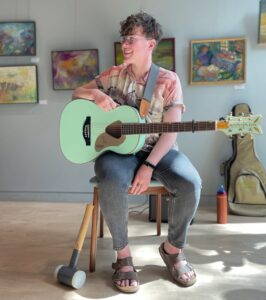Katie Castagno is a geologist at Provincetown’s Center for Coastal Studies by day who goes home and writes songs at night. She remembers the moment she learned that the marine biologist Rachel Carson was not the straight scientist she’d imagined.

Castagno had walked past a statue of Carson every day for five years — she was getting her Ph.D. in geological oceanography jointly through MIT and the Woods Hole Oceanographic Institution, where a statue of Carson was erected in 2013. It depicts Carson sitting straight-backed, bronze and poised, legs placidly crossed and her lips tilted up in a near-smirk as she holds pen to page.
Carson, who died at 56 in 1964, was a preeminent conservationist whose groundbreaking book Silent Spring shed light on the consequences of chemical pesticide use. Carson had spent summers in Woods Hole studying coastal ecology. She was also the first woman to venture out on a Bureau of Fisheries research vessel.
In 2021, Castagno came across a tweet about Carson being queer. The post led her to an academic journal article — “a fitting transition since so much of my work as a geologist involves reading journal articles,” Castagno says. The article by Lida Maxwell introduces Carson’s long-term partner, Dorothy Freeman. The hundreds of surviving letters they exchanged “depict their love as a wondrous multispecies achievement constituted through encounters with birds,” Maxwell writes.
“I was absolutely floored,” Castagno says. “It was something that had been completely left out of my understanding and education about who she was as a person.”
The piece gave new meaning to a scientific figure Castagno thought she’d known well. Carson’s queerness, excluded from the usual narrative record, left Castagno wondering: who else?
So, she put her science research skills to work. Two years later, with a cluster of stories and speculations under her belt, Castagno is putting on a show about these historical figures. She’ll perform a series of original musical numbers, “Our Queer Elders: LGBTQ History Through Song,” at the Eastham Public Library at 6 p.m. on Tuesday, Feb. 27.
The show will be “part sentimental and part cheeky,” Castagno says, as it looks to “celebrate and elevate the lives of queer icons throughout history.” Castagno will perform on guitar, vocals, and an instructional — but fun — slide show. “A quick little history lesson,” she says.
Her subjects include Eleanor Roosevelt, whose longtime dream of flying an airplane allegedly materialized after a White House dinner party that Amelia Earhart attended.
“They snuck out in their evening gowns, and Amelia and Eleanor took a little joyride over D.C.,” Castagno says. “Rumor has it that Amelia let Eleanor touch the controls.”
Accounts of that 1933 jaunt to Baltimore and back vary. It seems that this really did happen, aboard a twin-engine biplane. It even inspired a 1999 picture book: Amelia and Eleanor Go for a Ride. Franklin Roosevelt, who was against his wife taking to the skies for safety reasons, was away on vacation and likely not told. But whether Earhart’s husband, George Putnam, or Eleanor’s brother Hall joined them varies depending on the source. In other words, accounts of the intrigue are consistent but the details less so.
For Castagno, those historical wisps are fertile ground for musical guesswork. Speculation aids song.
“I mean, it just seems like the best first date. I would cease to exist,” Castagno says matter-of-factly. Her song about the airborne encounter is told from Roosevelt’s perspective.
With Carson, Roosevelt, and others, Castagno has developed a trove of queer stories seldom told and spun them into original songs. “I write a lot of songs about myself and my feelings,” she says. “And it’s been very refreshing to write songs about other people and their feelings.”
There’s the synergistic but unlikely pairing of American astronaut Sally Ride and Russian cosmonaut Svetlana Savitskaya, whose bond defied — or rose above — Cold War era politics. The first and second woman respectively to travel to space, the two were absolutely prohibited from interacting. But at a party in Budapest, Castagno says, the two “locked eyes, and Sally arranged a clandestine meeting just because they wanted to talk about being women in space.”
Because of the taboo, politically and socially, on top of the gaps in the historical archive, details of that encounter are likewise elusive. There are rumors that Ride wished to give Savitskaya a gift during that meeting — “the joke is she gave her the shirt off her back,” says Castagno.
Castagno will also sing about Emily Dickinson’s “very intense relationship with her sister-in-law.”
The narrative whispers that Castagno found combing through the online trove of buried queer stories, copious but incomplete, gave way to music. And the gaps left ample room to fill them in.
As Castagno set out to turn queer rumor into music, she realized that when it comes to unknown queer forebears, “the more you look, the more you find.”



